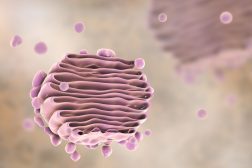Definition
noun, plural: glycoproteins
Any of the conjugated proteins, characterized by having one or more covalently-linked carbohydrate residues
Supplement
Glycoconjugates are carbohydrates that are covalently linked to another biomolecule via glycosylation and the carbohydrate constituent of the complex is called a glycan. Examples of glycoconjugates are glycoproteins, glycopeptides, peptidoglycans, glycosides, glycolipids, and lipopolysaccharides.
A glycoprotein pertains to any protein covalently attached to a carbohydrate unit through the process of glycosylation. Some of the common carbohydrate constituents of glycoproteins are β-D-glucose, β-D-galactose, β-D-mannose, α-L-fucose, N-acetylglucosamine, N-acetylgalactosamine, N-acetylneuraminic acid, and xylose. The carbohydrate constituent is attached to the protein via the -OH group of serine or threonine (i.e. O-glycosylated) or via the amide NH2 of asparagine (i.e. N-glycosylated).
Some of the examples where glycoproteins are found naturally:
- collagen
- mucins
- transferrin
- ceruloplasmin
- immunoglobulins
- antibodies
- histocompatibility antigens
- hormones (e.g. follicle-stimulating hormone, luteinizing hormone, human chorionic gonadotropin, thyroid-stimulating hormone, erythropoietin, alpha-fetoprotein)
- various enzymes (e.g. patatin, alkaline phosphatase)
- various proteins involved in cell to cell interactions
- lectins
- selectins
- various protein receptors, especially involved in hormone and drug action
- calnexin
- calreticulin
- certain regulatory proteins for growth and development
- certain surface protein membranes of platelets, particularly involved in thrombosis
While technically describing conjugates in which the carbohydrate is less than 4 percent by weight, the term is often used generically to include the mucoproteins and proteoglycans. However, differences in the usage of the terms: glycoprotein, proteoglycan, peptidoglycan, and glycopeptide exist, and therefore, prudence in the usage of these terms has to be exercised.
For instance, proteoglycans may be regarded as a subset of glycoproteins since both of them have a protein core. However, there are differences in several aspects. In structure, glycoproteins have carbohydrate chains attached to a polypeptide side chain whereas proteoglycans have glycosaminoglycan chains attached to the polypeptide. Glycoproteins have lower percentage of non-protein content by weight than proteoglycans (which, in turn, have higher, about 50-60%).
See also:
Related term(s):
- A1-acid glycoprotein
- Amyloidogenic glycoprotein
- Env glycoprotein
- Glycine-rich beta-glycoprotein
- Glycoprotein hormone-specific n-acetylgalactosamin
- Glycoprotein-n-acetylgalactosamine 3-beta-galactos
- Invariant surface glycoprotein 100
- Mucus glycoprotein sulfotransferase
- Myelin-associated glycoprotein
- P-glycoprotein
- Platelet glycoprotein gpiib-iiia complex
- Thy 1 glycoprotein
- Variable surface glycoprotein




